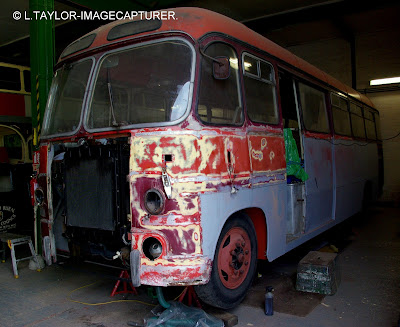1954 KARRIER.
Model- Mini coach. The Commer Karrier Company was the commercial vehicle arm of the Rootes Group, with assembly factories in Luton and Dunstable. This coach was assembled at Dunstable, but the 2,266cc engine and gearbox were made at the Rootes factory in Stoke, Coventry. The body was built by Reading and Company of Portsmouth. The museum acquired the vehicle in 1980 when it was generously donated by the Leicester Mission for the Deaf. The vehicle was restored to its original livery by the museum workshop in 1988.
~~~~<<<<>>>>~~~~
1973 DAIMLER FLEETLINE BUS.
Engine - 10,450cc. Top speed - 50 mph. The fleetline was the last in a long line of buses manufactured by Daimler and used by Coventry transport. This particular vehicle was the last completed fleetline and was delivered to Coventry Transport in 1973. The museum acquired this bus in 1986 and converted it into an open-topper. Its first public appearance after the conversion was to carry the victorious Coventry City football team on their triumphant tour around the city following their victory in the 1987 F.A.Cup Final.
~~~~<<<<>>>>~~~~
1948 MAUDSLAY MARATHON MKII COACH.
Engine- 7,900cc. Top Speed- 50mph. The Maudslay Company were once a longstanding Coventry car and commercial vehicle builders with a factory in the Parkside area of the city. This coach was first used by the coach tour operators, Hacketts of Manchester. It is powered by a six cylinder petrol engine. By the 1940s most heavy buses and coaches were powered by diesel engines although some high grade coaches, like this Maudslay, were still using petrol engines.
~~~~<<<<>>>>~~~~
LEYLAND BUSES.
~~~~<<<<>>>>~~~~
BARTONS BUS RECOVERY VEHICLE.
~~~~<<<<>>>>~~~~
ATLANTEAN.
The Leyland Atlantean is a double-decker bus chassis manufactured by Leyland Motors between 1958 and 1986. It pioneered the design of rear-engine, front entrance double deck buses in the United Kingdom, allowing for the introduction of one man operated buses, dispensing with the need for a bus conductor.
~~~~<<<<>>>>~~~~
DAIMLER BUS.
~~~~<<<<>>>>~~~~
1949 AEC REGAL III.
Ordered by Enterprise Passenger Services of Scunthorpe as their no 60, this dual purpose (bus/coach) vehicle was first licensed by Lincolnshire Road Car in 1950, after Enterprise had been taken over by Road Car and it had been in store for several months, then numbered 860. This vehicle has air brakes and an air operated pre selector gearbox. It spent most of its life with LRCC at Scunthorpe being withdrawn in 1961 and later being used by various contractors in North Lincolnshire area. Eventually it was sold for scrap by a potato company to a dealer at Worksop, following a mechanical failure, but was rescued by a society member in the early 1970s. After much work, both mechanically and bodily, it is now in the livery it first entered revenue earning service with the Lincolnshire Road Car.
~~~~<<<<>>>>~~~~
1935 LEYLAND TIGER TS7.
Leyland single deck buses were the mainstay of the pre-war Lincolnshire Road Car fleet, with 88TS7 and TS8 models being purchased. This TS7 example originally carried number LT370 and was one of the first buses in the county to be powered by a diesel rather than a petrol engine. A new Burlingham body replaced the original Brush body in 1949, it was renumbered 1411 in 1953 and remained in service with Road Car until 1959.
~~~~<<<<>>>>~~~~
1966 BRISTOL RELH6G WITH AN ECW DP47F BODY.
The 1960s saw the advent of the rear engine bus, the Bristol RE being the most successful of the single deck designs. This is an example of the coach version supplied new to Lincolnshire Road Car as fleet number 1431. Later downgraded to service work, it was withdrawn from service in 1982 and subsequently acquired for preservation.
~~~~<<<<>>>>~~~~
1929 LEYLAND LION LT1 WITH APPLEWHITE B32R BODY.
One of four Lions that Lincoln Corporation took delivery of with bodywork by local coachbuilder Applewhite's. When new they had concrete floors and were known as `Fireproofs` by staff. No 5 remained in service until 1949, after which it was used as a snowplough, before being sold in 1959 to Sid Twell of Ingham. It stood in his yard until being donated to the society in 1959 and was then dry stored for 25 years before being restored as an apprentice scheme by Lincoln City Council, after which it saw active service again for a while on city tour duty.
~~~~<<<<>>>>~~~~
1929 CHEVROLET LQ WITH A SPLICER C14D BODY.
This little coach was used on daily tours from Morecombe to the lake district until the early 1950`s. Of American design, this make was the predecessor of the famous Bedford marque.
~~~~<<<<>>>>~~~~
VARIOUS BUSES AWAITING RESTORATION.
~~~~<<<<>>>>~~~~






















That Karrier at the top reminds me of a very versatile vehicle in the same time period called a DIVCO. You would find them in every configuration possible. Neat vehicles. But you gotta love them double decker buses. Aw, come on. I never got to ride in one, but always wanted to. Still do. Dangit. I'm jealous!!! That 1929 Chevy is neat looking. Never saw one of those. I'd be proud to ride in that 66 Bristol. Snazzy looking. I like them all and would certainly love to ride in them. Great subject matter, my friend!!! Loves them buses.
ReplyDelete